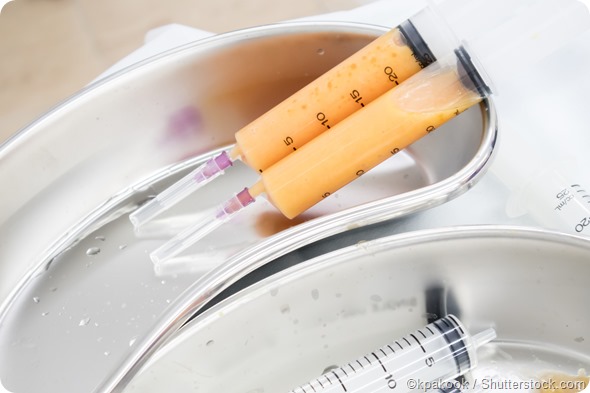Dermal fillers are effective treatments used to soften and reduce wrinkles and deep lines, fill out the cheeks and smooth facial contours. There are four main types of injectable dermal fillers, including fat, collagen, hyaluronic acid, and microsphere-containing carriers of another material such as polymethyl methacrylate (PMMA). These fillers are described in more detail below.
Fat injections
Fat harvested from a part of the patient’s body such as the thighs, buttocks, or abdomen is re-injected into areas of the face that have started to lose fat. This can improve facial fullness, fill in wrinkles and build up hollow areas. A blunt cannula is used to inject harvested fat droplets into the facial areas that require treatment. The grafted fat then develops a new blood supply in order to survive.
As living tissue, the fat needs to be handled gently; improper placement of volumes that are too large can lead to the tissue failing to “take.” Slow, incremental placement increases the chance of the tissue being able to form the required blood supply. The success rate varies between individuals, based on a variety of factors. However, once the blood supply is established, the graft usually “blossoms” for about 18 months after the surgery.
When this happens, the graft can become a permanent part of the soft facial tissue, which provides much better results than the use of synthetic fillers, which usually requires follow-up treatments at least once a year.

Collagen injections
The second layer of the skin (dermis), which lies just below the outer layer (epidermis) is mostly made up of collagen, a supportive network of fibers that enables the growth of cells and blood vessels. Scientists have managed to use this collagen as a filler to soften the signs of aging, add volume to the face and fill in scars. The collagen may come from humans or animals. Results can last for up to four months.
Hyaluronic acid (HA)
HA is a commonly used substance that is found in more than 30 dermal fillers. The substance occurs naturally in the human body and serves as a network for transferring nutrients from the blood to skin cells. HA is present at high concentrations in soft connective tissue. It is also found in the fluid that surrounds the eye, some cartilage and fluid in the joints.
On injection, HA behaves like an inflated cushion, supporting tissues and structures in the face that may have become less elastic or lost volume. It also brings water to the skin surface, helping it to look fresh and supple. The effects last between six and nine months, after which top-up treatments are usually given about twice a year.
Calcium Hydroxylapatite
This is the heaviest type of dermal filler and it is used to fill moderate-to-severe wrinkles such as frown lines, marionette lines (those around the sides of the mouth), and nasolabial folds (laughter lines). It can also be used to improve fullness in the cheeks and other contours of the face. The filler is made up of tiny, almost microscopic calcium particles suspended in a smooth gel.
This type of filler produces very natural results and is reported to stimulate the natural production of collagen. Calcium hydroxylapatite is typically thicker than HA filler and results last longer, for around 12 months.
Poly-L-lactic Acid (PLLA)
Poly-L-lactic acid is a biodegradable, synthetic material that is gradually absorbed by the body and is commonly used for dissolvable stitches. It is one of the thicker fillers and is generally used to treat deeper lines that have arisen as a result of age-associated collagen loss.
PLLA is injected into the dermis, where collagen strands support the structure of the skin. As the PLLA microparticles are absorbed, they stimulate collagen production, which rebuilds collagen strands and restores the structure and volume of the skin. The number of appointments needed for injections varies between individuals depending on how much collagen has been lost, but, generally, the injections are administered three times over the course of a few months. It is classified as a semi-permanent filler, with the results usually lasting around two years
Polymethyl methacrylate (PMMA)
PMMA is a synthetic, biocompatible substance that, when used in dermal fillers, takes the form of microspheres that settle beneath the skin to provide continued support. The filler also contains collagen, which provides further structure and firmness to the skin. PMMA fillers consist of approximately 20% PMMA microspheres suspended in about 80% of purified collagen gel.
A few months after it is injected, the collagen breaks down, which stimulates the body to produce its own new collagen to restore the space in the skin. The new collagen tethers the PMMA microspheres in place, thereby preventing migration. PMMA fillers are considered semi-permanent treatments and are generally used to treat medium to deep wrinkles and folds. It can also be used for lip augmentation and to fill pitted scars.
Sources
- www.plasticsurgery.org/…/dermal-fillers-calcium-hydroxylapatite
- http://baaps.org.uk/procedures/cosmetic-facial-injections
- my.clevelandclinic.org/cosmetic-plastic-surgery/procedures/injectables
- www.plasticsurgery.org/…/dermal-fillers?sub=Types+of+dermal+fillers
- www.plasticsurgery.org/…/dermal-fillers
- http://www.aafprs.org/media/media_resources/fatGrafting.html
- www.plasticsurgery.org/cosmetic-procedures/dermal-fillers-collagen
Further Reading
- All Cosmetic Surgery Content
- The Benefits and Risks of Laser Tattoo Removal
- What is Laser Hair Removal?
- Health Risks of Laser Hair Removal
- Cosmetic & Medical Injectables Overview
Last Updated: Feb 26, 2019

Written by
Sally Robertson
Sally has a Bachelor's Degree in Biomedical Sciences (B.Sc.). She is a specialist in reviewing and summarising the latest findings across all areas of medicine covered in major, high-impact, world-leading international medical journals, international press conferences and bulletins from governmental agencies and regulatory bodies. At News-Medical, Sally generates daily news features, life science articles and interview coverage.
Source: Read Full Article
